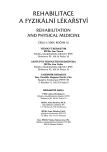Evaluating Hand Motor Performance in a Chronic Stage after Brain Stroke – Finger Tapping Test
Authors:
D. Tomisová; J. Opavský
Authors‘ workplace:
Katedra fyzioterapie, Fakulta tělesné kultury UP, Olomouc
vedoucí katedry prof. MUDr. J. Opavský, CSc.
Published in:
Rehabil. fyz. Lék., 16, 2009, No. 1, pp. 11-15.
Category:
Original Papers
Overview
The aim of this paper was to describe a practically applicable evaluation of fine motor task performance components of paretic hand of patients after brain stroke in chronic phase with use of the apparatus for examination of frequency barrier of finger tapping - Finger Tapping Test.
We chose the Nine-Hole Peg Test for comparison, which is most commonly used in practice for the assessment of hand motor skills. We observed the character and dynamics of changes achieved after 10 rehabilitation procedures.
The Finger Tapping Test appears to be a suitable method for the examination of fine motor task performance of paretic hand after brain stroke in chronic phase. This fact is confirmed by correlation of this method with Nine-Hole Peg Test.
Key words:
brain stroke, the Nine-Hole Peg Test, Finger Tapping Test, rehabilitation procedures
Sources
1. ANONYMOUS, A. : Nine-Hole Peg Test for finger dexterity. Retrieved from the World Wide Web [on line 23.3.2005]
2. ANONYMOUS, B.: Nine Hole Peg Test. Retrieved from the World Wide Web [on line 23.3.2005]
3. AOKI, T., FRANCIS, P. R. & KINOSHITA, H.: Differences in the abilities of individual finger during the performance of fast, repetitive tapping movements. Exp. Brain Res., 125, 2003, s. 270-280.
4. AOKI, T., TSUDA, H., TAKASAWA, M., OSAKI, Y., OKU, N., HATAZAWA, J. & KINOSHITA, H.: The effect of tapping finger and mode differences on cortical and subcortical activities: a PET study. Exp. Brain Res., 160, 2004, s. 375-387.
5. BOHNANNON, R. W., SMITH, M. B.: Interrater reliability of a modified ashwort scale of muscle spasticity. Phys. Ther., 67, 1987, s. 206-207.
6. CALAUTTI, C., JONES, P. S., PERSUD, N., GUINCESTRE, I. Y., NACCARATO, M., WARBURTON, E. A. & BARON, J. C.: Quantification of index tapping regularity after stroke wtih Tri-axial accelerometry. Brain Research Bulletin, 70, 2006, 1, s. 1-7.
7. CARR, J. H. & SHEPHERD, R. B.: Neurological rehabilitation: Optimizing motor performance. Oxford, Butterworth-Heinemann, 1998.
8. DE GROOT-DRIESSEN, D., SADE, P. & HEUGTEN, C.: Speed of finger tapping as a predictor of functional outcome after unilateral stroke. Arch. Phys. Med. Rehabil., 87, 2006, s. 40-45.
9. HATANAKA, T., KOYAMA, T., KANEMATSU, M., TAKAHASHI, N., MATSUMUTO, K., DOMEN, K.: A new evaluation method for upper extremity dexterity of patients with hemiparesis after stroke: The 10-second tests. International Journal of Rehabilitation Research, 30, 2007, 3, s. 243-247.
10. INUI, N.: Lateralization of bilateral transfer of visuomotor information in right-handers and left-handers. Journal of Motor Behaviour, 37, 2005, 4, s. 275-283.
11. JÄNCKE, L., STEINMETZ, H., BENILOW, S. & ZIEMANN, U.: Slowing fastest finger movements of the dominant hand with low-frequency rTMS of the hand area of the primary motor cortex. Exp. Brain Res., 2004, 155, s. 196-203.
12. LIU, W., FORRESTER, L. & WHITALL, J.: A note on time – frequancy analysis of finger tapping. Journal of Motor Behaviour, 38, 2006, 1, s. 18-28.
13. OPAVSKÝ, J.: Neurologické vyšetření v rehabilitaci pro fyzioterapeuty. Olomouc, Nakladatelství UP, 2003.
14. SHIMOYAMA, I., NONCHOJI, T. & UEMURA, K.: The finger-tapping test. A quantitative ananlysis. Archives of Neurology, 47, 1990, 6.
15. VAVERKA, F., HANUS. T.: The frequency of the finger movement and the laterality of upper extremity in current research in motor kontrol. Katovice, 2000, s. 215-218.
Labels
Physiotherapist, university degree Rehabilitation Sports medicineArticle was published in
Rehabilitation & Physical Medicine

2009 Issue 1
- Hope Awakens with Early Diagnosis of Parkinson's Disease Based on Skin Odor
- Deep stimulation of the globus pallidus improved clinical symptoms in a patient with refractory parkinsonism and genetic mutation
Most read in this issue
- Evaluating Hand Motor Performance in a Chronic Stage after Brain Stroke – Finger Tapping Test
- Vertebrobasilar Complications in Manipulation Treatment of Cervical Spine
- What is the Way of Vojta’s Method Functioning
- Comparison of Efficient Mud Bath Tub and Mud Wraps in an Alternative Way
